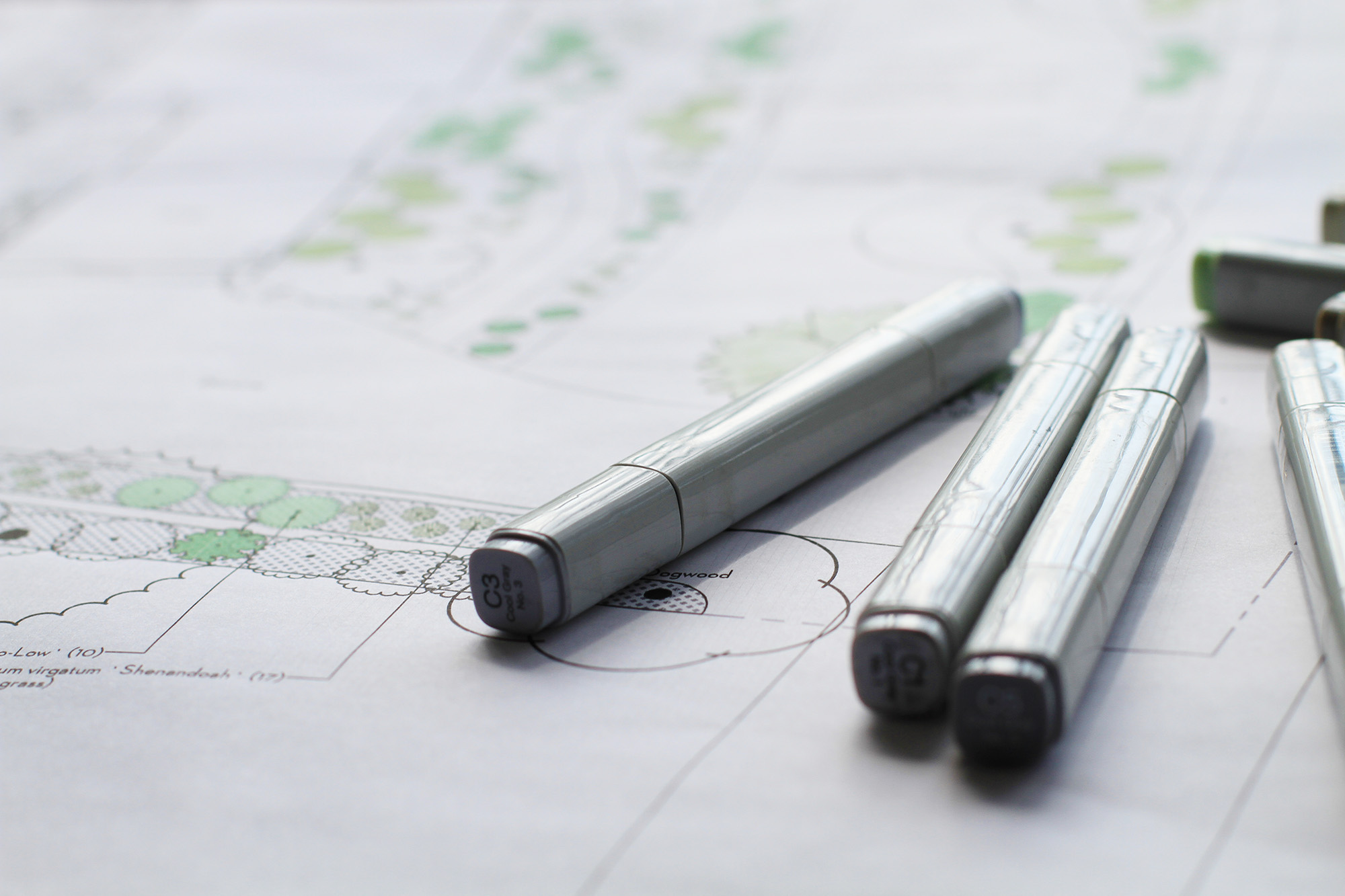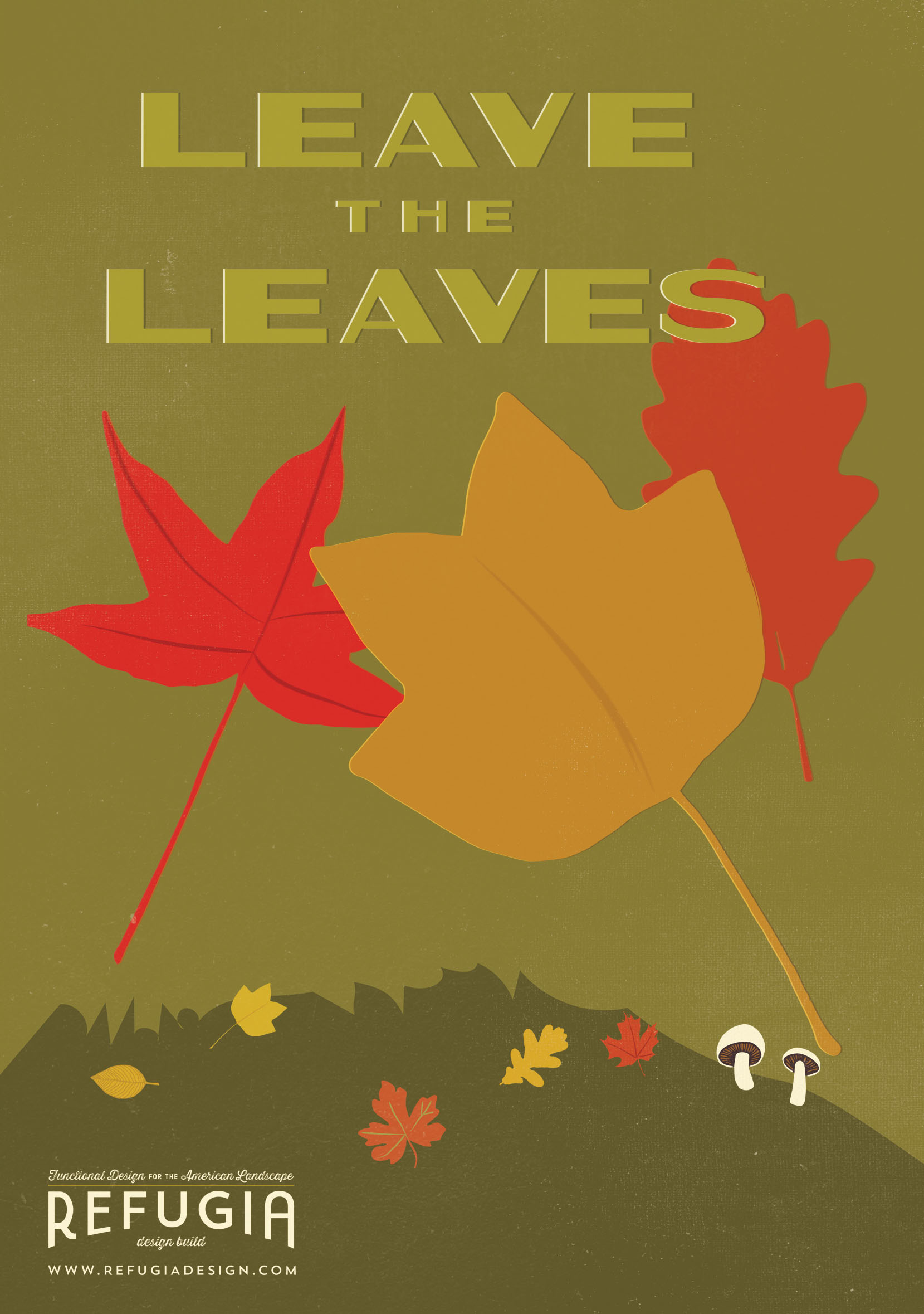
Our Process
At Refugia, we design functional landscapes that are ecologically beneficial, beautiful, and resilient. Sown from our own field experiences and fostered by our commitment to continuing education, below you’ll find a few of our best practices that set us apart from conventional landscape management and design.
CHOOSE NATIVE PLANTS
Refugia uses native plants to create landscapes that are beautiful in all seasons and perform a myriad of ecological functions. Native plants evolved in association with other local plant species, fungi, insects, pollinators, and wildlife. Over time, they have adapted to local climate and soil conditions, reducing the need for both maintenance and excessive inputs like water and fertilizer. Mutually beneficial to both humans and wildlife, native plants create a sense of place and connect us to the natural world and our local ecosystem.
Ecosystems contain a network of checks and balances, creating our local “food web”; which is a network of food chains that exist in any ecological community. It is a complex system that supports all life on our planet - from the fungus to the trees to large mammals (like us!). Non-native ornamental species regarded as “pest-free” do not enter this system and actually distort the natural balances. As a result, insect, bird, and wildlife populations are adversely affected; they have fewer sources of food and habitat, which are both contributing factors to population decline. Additionally, because the growth of non-native plants is not checked by other species, many have invasive tendencies and “escape” from planned landscapes into natural forest and meadow areas, stifling native plant regeneration, and reducing ecosystem biodiversity in all levels of the food web.
BEAUTY IS IN THE UNDERSTATED
What sets our design aesthetic apart is our emphasis on the understated, yet beautiful. Texture, form, structure, and function are present in our native landscapes. Rather than relying on showy annuals that need to be re-planted year after year, we primarily use perennials. As part of your design package, you will receive a bloom and color schedule that shows you when each of your plants will display color throughout the year. We emphasize landscapes that are beautiful in all seasons, including winter. Our designs are full of subtle surprises - textured bark, brilliantly colored branches, delicately patterned buds, bright berries, along with seedheads and grasses that provide structure through winter. As designers, we envision your outdoor space as an extension of the home. We approach yard design as the creation of outdoor rooms that extend your living space outdoors and create functional spaces for dining, playing, gardening, and gathering. We can work with you to increase privacy screening, buffer noisy roads, create bird and butterfly habitat, manage stormwater, decrease lawn maintenance, and more.
DESIGN COLLABORATIVELY
Each member of our team brings a unique set of experiences and education to our work. These diverse backgrounds are our strength. We’ve studied biology, landscape architecture, design, ecology, permaculture, land management, and ecological restoration - all of which inform our approach to projects. We believe it is important to engage this collective knowledge through a collaborative design process.
SOIL IS A HABITAT
Often, soil testing analysis confirms that you’ve got dirt - poor soil that’s been compacted, has little organic matter, and offers little to plant or human life. Rather than using excessive quantities of fertilizers and pesticides that leach into our waterways, as done in conventional landscape practices, Refugia offers a Comprehensive Landscape Management Plan. Our integrative approach is customized to support the establishment of your native landscape, employing ecologically-based management practices that regenerate and restore plant and soil communities. Besides the obvious benefit of healthy vibrant plants, healthy soils save you money by reducing the need for unnecessary inputs that lead to environmental degradation. Plants that form partnerships with soil microbes and fungi require 20-30% less water and fertilizer than those grown in sterile or degraded soils. Below we’ve highlighted some of the ecosystem services that contribute to a resilient and self-sustaining landscape, benefiting both you and your family, along with the local environment: Carbon cycling and sequestration Nutrient cycling, decomposition of organic matter, fungi as Earth’s “biological disassemblers” Water infiltration, which keeps more water on site and below ground Increased biomass, in the form of primary producers, which fuel the food web Increased biodiversity above and below the soil Filtration of pathogens and pollutants from both water and soil Storm water and erosion control Decreased inputs in the forms of fertilizers, water, herbicides, and pesticides Improved plant health, soil stability, resistance to climate stress, disease resistance
WE plant responsibly
Our nursery is a holding space for herbaceous plants, trees, and shrubs; some of which we grow ourselves. We make every effort to source the plant material that we aren’t able to grow in-house from local wholesale growers. We are lucky to have great local growers, many of whom share our same values including using local ecotypes, limiting pesticide and herbicide-use, and producing high quality plant material that will thrive in the landscape.
Many native plants are highly adaptable species; the same species of plant that might be found in your local park could also be found in the Smoky Mountains of North Carolina, for example. While they are the same species, they have each adapted to their own set of specific environmental conditions - cold hardiness, drought tolerance, root structure, etc - which influence their survival in that particular location. We are working to increase our use of local ecotypes and local seed from the Mid-Atlantic area because of these important region-specific adaptations that help to ensure plant health and survivability.
REPLACE TRADITIONAL TURF GRASS WITH ECOLOGICAL ALTERNATIVES
Lawns require significant maintenance; weekly mowing and frequent fertilizing can be detrimental to your time, wallet, and watershed. Excess fertilization pollutes storm water runoff, which enters the watershed and negatively impacts aquatic and marine ecosystems. We often suggest replacing some areas of your lawn with native alternatives such as creeping red fescue, Pennsylvania sedge, or other no-mow grass options. Once established, these native ground covers don't require watering and only need to be mowed once a year. We understand the benefits that some lawn space offers for play, gathering, and recreation, and as such, are happy to create a space where both types of ground cover coexist.
LEAVE THE LEAVES
Join us in our “Leave the leaves!” campaign. Autumn leaves provide a multitude of ecological functions when retained in your garden. Most importantly, leaves act as a natural fertilizer, slowly releasing nutrients back into the soil as they decompose, feeding both the plants and beneficial soil microbes. Leaves not only lighten heavy soils, but they also help sandy soils retain moisture. Finally, leaves insulate your tender plants from the winter cold. So instead of discarding your leaves, put them to work!

PINE STRAW INSTEAD OF CONVENTIONAL MULCH
In the forest, the ground cover “duff” layer is composed of leaves, pine needles, and other organic debris in various stages of decomposition. Taking our cues from natural ecosystems, we use these same materials as mulch in our landscapes. We use pine straw because it is a more sustainable material that does not require trees to be cut down, has no synthetic dyes or additives, and has a comparatively small fossil fuel footprint in regards to processing and transport. Our pine straw insulates your plants, helps retain soil moisture, suppresses weeds, and adds a striking natural element to your garden that is hard to replicate with conventional hardwood chips.
PRESERVE WINTER HABITATS
Our gardens play an important role in supporting wildlife year-round by providing food, habitat, and cover. As a result, Refugia waits until early spring to prune spent stems and seed heads. Spiked seed heads and sturdy stalks, such as those of the native coneflower, Echinacea purpurea, are left erect throughout winter, providing both food and cover for wildlife, especially bird populations. Dormant grasses remain uncut, serving as insulating windbreaks, habitat, and forage. Non-migratory bees, butterflies, and beneficial insects overwinter under leaf litter or on spent stalks awaiting warmer spring months when they can re-emerge to service your landscape via pollination, pest-control, and sheer beauty. The variety in plant form, texture, and color also give your garden fabulous winter interest—bright red berries peek through snow covered branches, fuzzy seed heads of asters and goldenrod seem to dance off the stalks, while warm colored grasses provide unique structural forms.
LIMITED IRRIGATION
Through our design process, we select plants that match your specific site conditions. Native plants are highly adaptable and often drought tolerant. With their extensive root systems and ability to retain precipitation, these plants require little watering once established. It is important to note that as plants are establishing, so too are the soil communities that exist below ground. Fungi and other beneficial microbes form symbiotic partnerships with plant roots beneath the soil surface. These partnerships ultimately serve as an extension of plant root systems, where plant sugars are exchanged for much needed nutrients. Upwards of 80% of wild plants depend on these associations, and planted landscapes that have healthy soil biology require 20-30% less water and fertilizer. As a result, we do not recommend installing irrigation systems. By the third year, your plants will be well-established and only require watering during severe drought conditions.
“Refugia transformed our property into a beautiful space teeming with life .. We now have many native species that we enjoy in every season. We could not have achieved this level of variety on our suburban property without the knowledge and partnership with Refugia .. We spend more time outside as a family and our children enjoy learning about all of the plants and trees and birds and insects. We are very pleased with this partnership and it was one of the best investments we have made in our home.”

